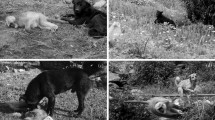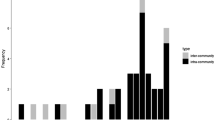Abstract
Hypotheses about the evolution of gregariousness and social organisation in primates are based on ecological explanations as well as on social factors such as conspecific threat (especially infanticide by males). The social explanation fits well with the conditions found in strepsirrhine primates and furthermore explains why infanticide in anthropoid primates living in one-male groups mainly occurs when the resident male (protector) is replaced. However, whether it likewise fits to the conditions in multimale groups will depend on the role of resident males as infant protectors, which has rarely been examined. We investigated long-term data of wild Hanuman langurs (Presbytis entellus) inhabiting a forest near the village of Ramnagar (southern Nepal). Twenty-two eye-witnessed attacks on infants by males were analysed in connection with male residency, paternity (DNA analyses) and sexual behaviour. Adult males played a major role in infant defence (65%). Only the genetic father or males who had been residents when the infant was conceived were observed to protect infants. Males who immigrated after a female had conceived may later attack her infant and were never observed to defend it. lt seems that the males took only copulations with potentially fertile females but not with pregnant females as clues for paternity. In the light of these results it seems likely that the risk of infanticide is an important determinant in female-male associations even in anthropoid primate multimale groups.
Similar content being viewed by others
Author information
Authors and Affiliations
Additional information
Received: 22 December 1998 / Received in revised form: 30 April 1999 / Accepted: 1 May 1999
Rights and permissions
About this article
Cite this article
Borries, C., Launhardt, K., Epplen, C. et al. Males as infant protectors in Hanuman langurs (Presbytis entellus) living in multimale groups – defence pattern, paternity and sexual behaviour. Behav Ecol Sociobiol 46, 350–356 (1999). https://doi.org/10.1007/s002650050629
Issue Date:
DOI: https://doi.org/10.1007/s002650050629




